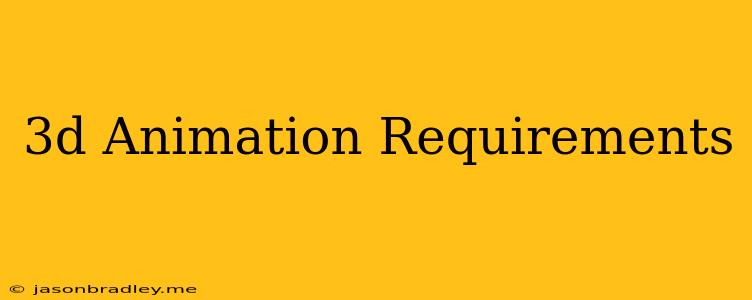3D Animation Requirements: Everything You Need to Know
Creating stunning 3D animations requires a comprehensive set of tools and skills. From software and hardware to artistic talent and technical expertise, a successful animator needs a diverse range of capabilities. Here's a breakdown of the key requirements for 3D animation:
Software:
- 3D Modeling Software: Programs like Maya, 3ds Max, Blender, and Cinema 4D are essential for creating the 3D models that form the foundation of your animation. These software packages offer powerful tools for building, sculpting, and manipulating objects in a virtual 3D space.
- Animation Software: Software specifically designed for animation, like Maya, Houdini, MotionBuilder, and Character Animator, allows you to bring your models to life. They provide tools for keyframing, motion capture, rigging, and other animation techniques.
- Rendering Software: Rendering software like V-Ray, Arnold, Redshift, and Octane are crucial for converting your 3D models and animations into final images or videos. These programs simulate light and materials to create realistic and visually appealing results.
- Compositing Software: Programs like After Effects, Nuke, and Fusion are used to combine different elements, add special effects, and create the final polished look of your animations.
Hardware:
- Powerful Computer: 3D animation requires a lot of processing power and memory. You'll need a computer with a fast processor (CPU), ample RAM, and a dedicated graphics card (GPU).
- Large Storage Space: 3D models, textures, and animations can take up a considerable amount of space. Ensure you have a large enough hard drive or SSD to accommodate your projects.
- High-Resolution Monitor: A large, high-resolution monitor will make it easier to see intricate details in your models and animations.
Skills:
- 3D Modeling: Strong modeling skills are essential for creating visually appealing and functional models. Understanding anatomy, form, and composition is crucial.
- Animation: This skill involves understanding the principles of movement, timing, and weight to bring life to your models.
- Rigging: Rigging is the process of creating a skeleton-like structure that allows your models to be animated smoothly.
- Compositing: This involves combining different elements, adding special effects, and creating the final look of your animation.
- Lighting and Materials: Knowing how to create realistic lighting and materials is essential for creating visually appealing animations.
- Storytelling and Visual Communication: You need to be able to tell a compelling story and convey information visually.
- Software Proficiency: Developing a strong command of your chosen software is essential for maximizing its potential.
Additional Resources:
- Online Tutorials and Courses: There are numerous online resources available for learning 3D animation, including tutorials, courses, and communities.
- Reference Materials: Using reference images, videos, and other resources can help you create more realistic and accurate animations.
- Collaboration: Working with other artists, animators, and technical experts can enhance the quality of your projects.
Conclusion:
Creating impressive 3D animations requires a combination of software, hardware, artistic skills, and technical knowledge. By investing in the right tools and developing your skills, you can unleash your creativity and create captivating 3D animation experiences.
